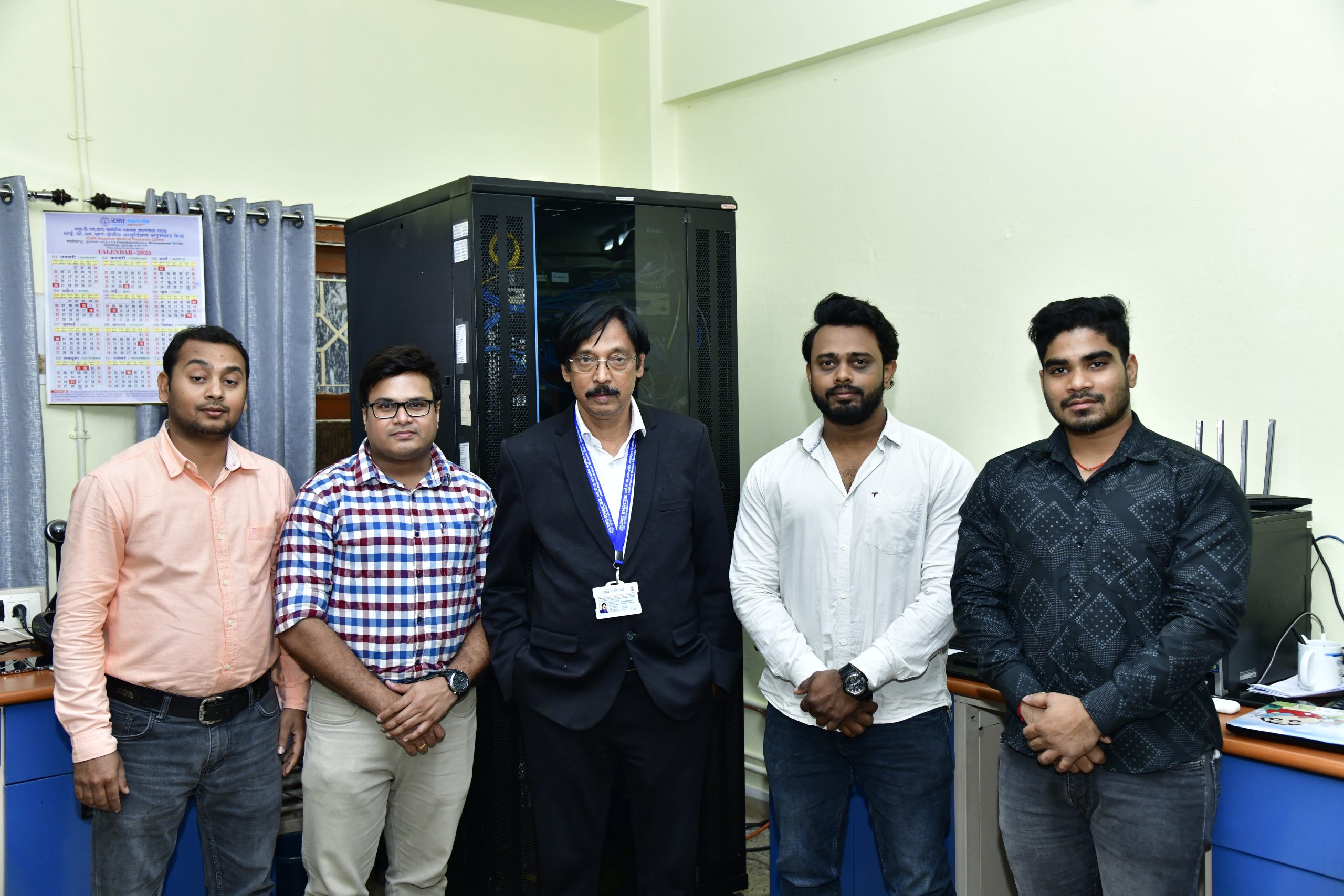Library & Information

Library, Information & IT Division
About ICMR-RMRC Library
Library & Information Centre of ICMR-Regional Medical Research Centre has been the life-line for the research activity of the institute. At present, it stands as a modern library & Information Centre with a lot of modern facilities with Wi-Fi enabled E-library. It is regarded as one of the best Bio-Medical Research libraries in Odisha. The library has been using the Koha an Integrated Library Management software package with all the modules for the library housekeeping operations. Using Koha OPAC, users can search the Library Online Catalogue by Author, Title, Subject, and keywords. The library has been using the Digital Repository software DSPACE for Scholarly Publications of ICMR-Regional Medical Research Centre, Bhubaneswar. The main objective of this repository is to collect, preserve, and distributes digital material i.e. scholarly publications of RMRC, Bhubaneswar.
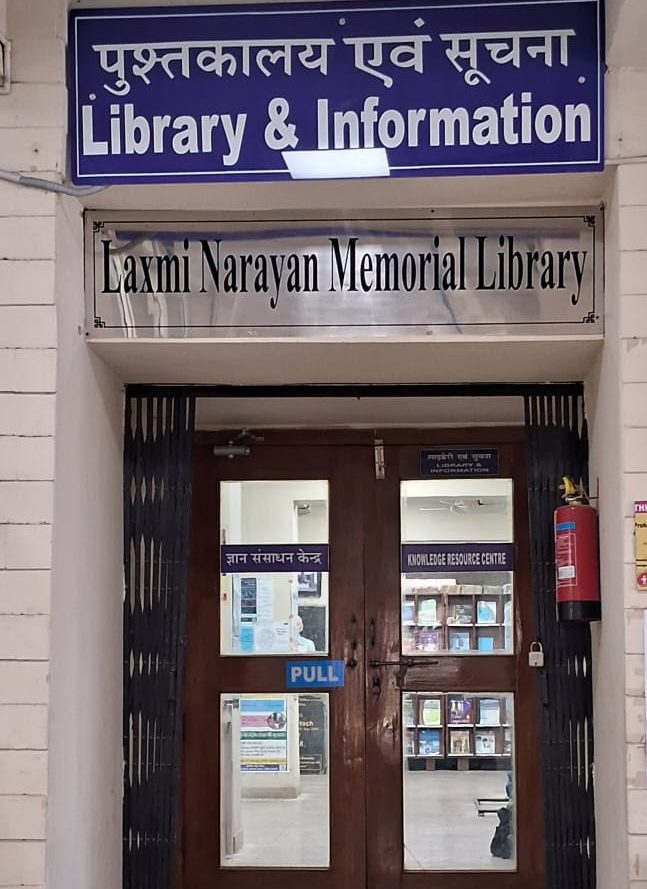
Library Collections:
Books :- 4432
WHO Books :- 1544
Bound Journals :- 5329
Thesis & Dissertations :- 306
E-resources:-
One Nation One Subscription(ONOS)
ERMED Consortia
EBSCO Database(CINHL)
EMBASE Database
Proquest Database
Library Timing:
9.00 AM to 5.30 PM (Monday to Friday)
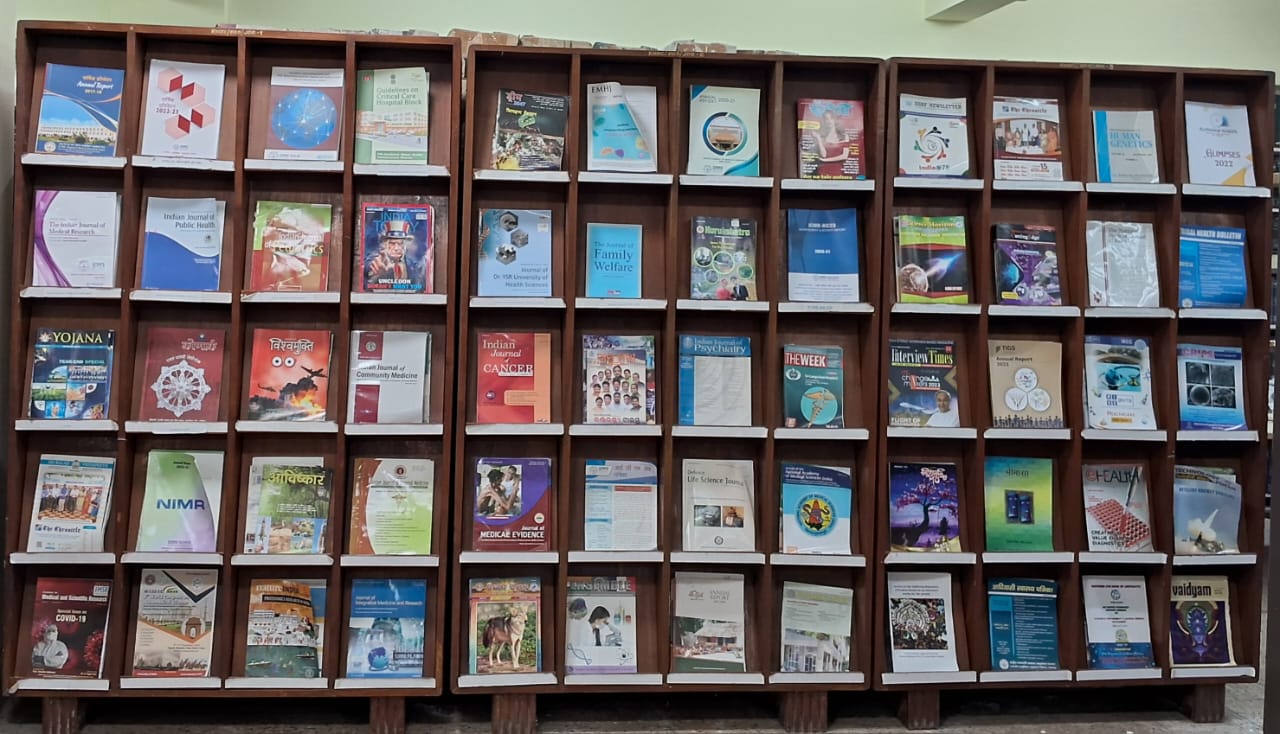
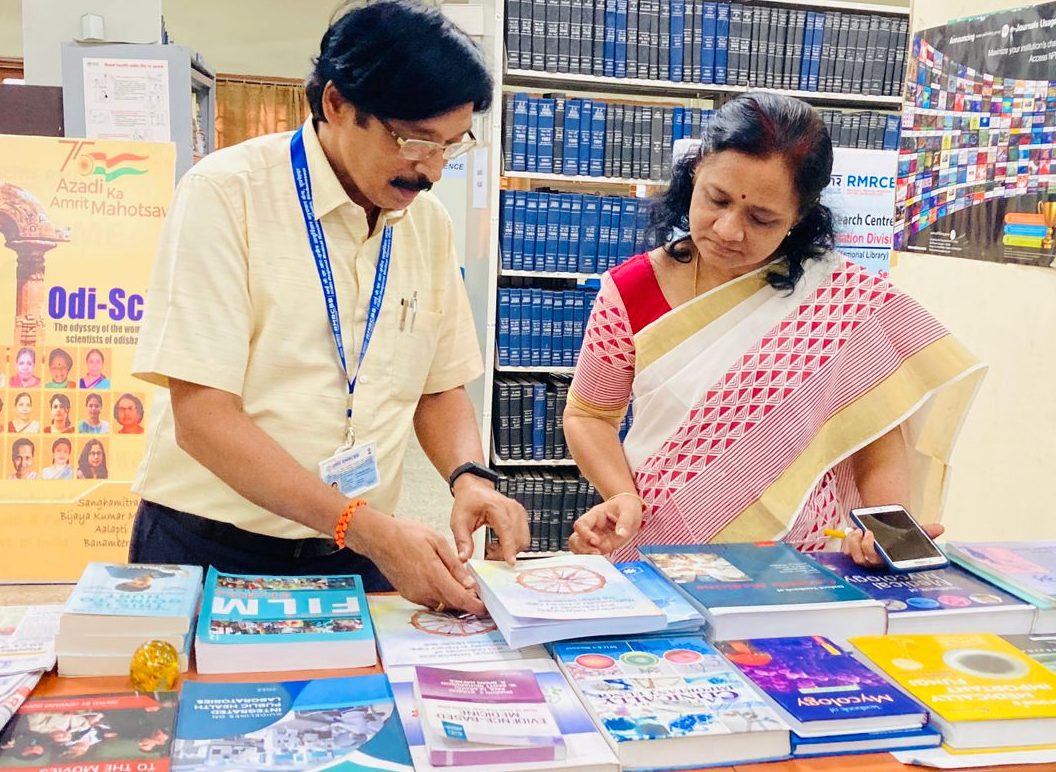
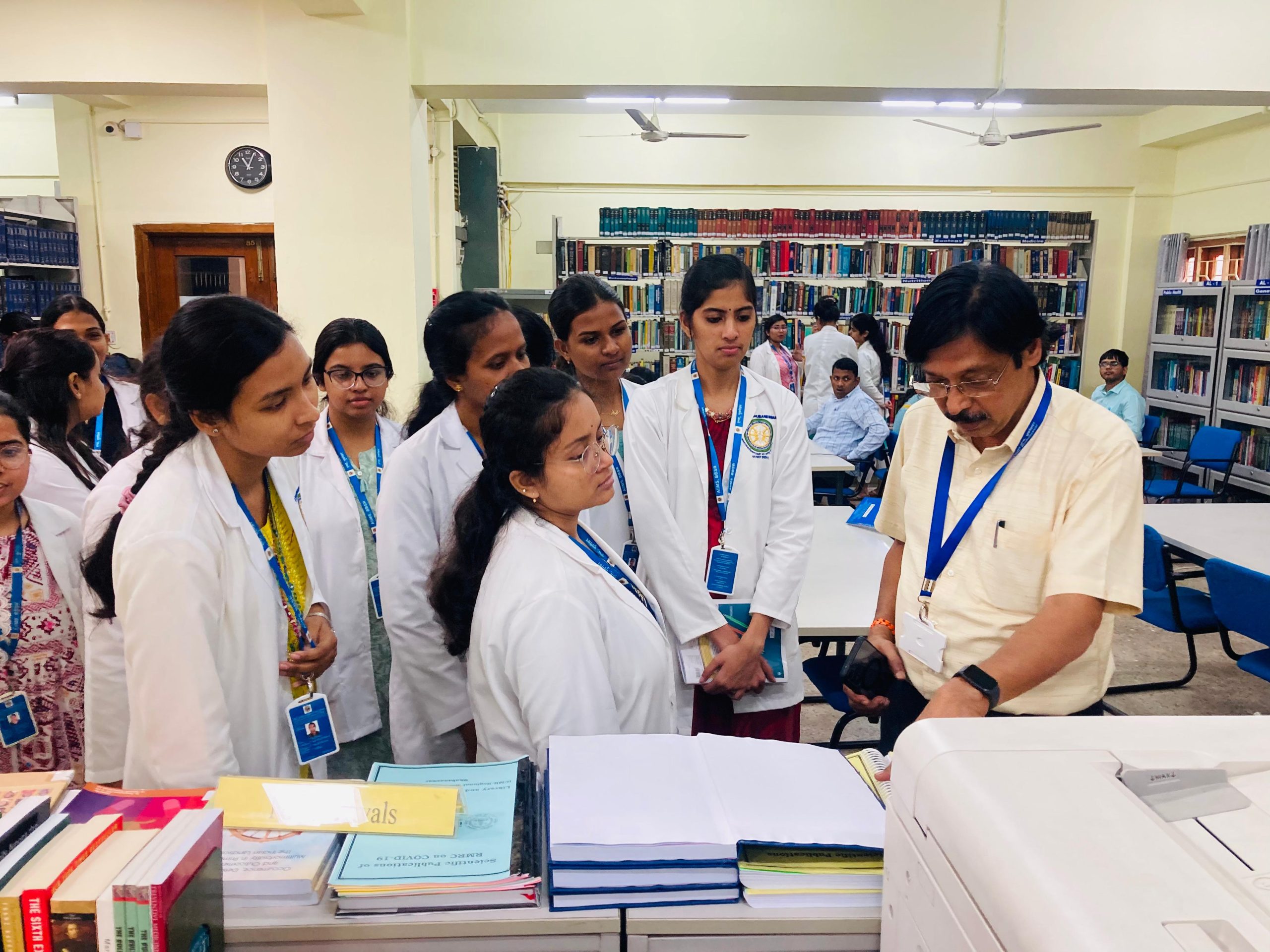


Library & Information Services in RMRC
One Nation One Subscription(ONOS):
The Prime Minister of India in his address to the Nation from the ramparts of the Red Fort on 15th August, 2022, had pointed out the importance of Research and Development in our country in the Amrit Kaal. He had given the clarion call of “Jai Anusandhan” on the occasion. The National Education Policy, 2020 (NEP 2020) has also identified research as a corequisite for outstanding education and development in our country. In response to the vision of making India Atmanirbhar and Viksitbharat@2047, the Government of India approved One Nation One Subscription scheme to provide country-wide access to international high impact scholarly research articles and journal publications to students, faculty and researchers of all Higher Education Institutions managed by the central government and state
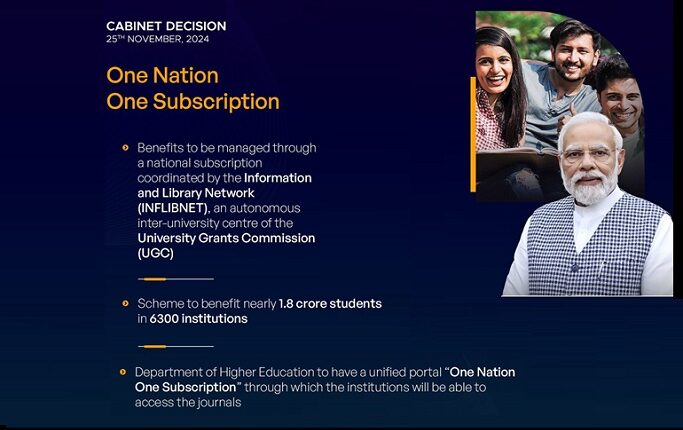
governments and Research & Development Institutions of the central government.
The scheme includes nearly 13,000 e-journals from 30 leading international publishers, such as Elsevier, Springer Nature, Wiley Blackwell, Taylor & Francis, and Oxford University Press. These journals will be accessible to over 6,300 government-run higher education and research institutions, offering extensive resources for academic growth.
The One Nation One Subscription (ONOS) intends to acquire national licenses for e-journal/database subscriptions from most of the prominent journal publishers. A total of 30 major international journal publishers have been included in ONOS. All the journals published by these publishers will be accessible to the students, faculty members and researchers of the participating institutions. ICMR-RMRC is a member of ONOS. The e-journals are IP-activated and can be accessed through a versatile platform www.onos.gov.in
EMBASE:
EMBASE is a comprehensive biomedical and pharmacological database, widely used by researchers and healthcare professionals for systematic review and meta-analysis. It focuses on drug research, pharmacology, and clinical medicine, covering a range of topics including drug development, medical devices, and more. The database includes a vast collection of indexed journals, conference abstracts, and other literature sources. EMBASE is valuable for evidence-based medicine, systematic reviews, and staying updated with medical advancements. The EMBASE resource can be searched and browsed through a versatile search platform i.e. www.embase.com.
ERMED Consortia:
National Medical Library’s Electronic Resources in Medicine (NML-ERMED) Consortium is an initiative taken by Dte.GHS & MOHFW to develop nationwide electronic information resources in the field of medicine for delivering effective health care. 70 state and centrally funded Government Institutions are selected as its members. The Consortium is being coordinated through its headquarter set up at the National Medical Library (NML). The ERMED resource can be searched and browsed through a versatile search platform i.e. www.nmlermed.in.
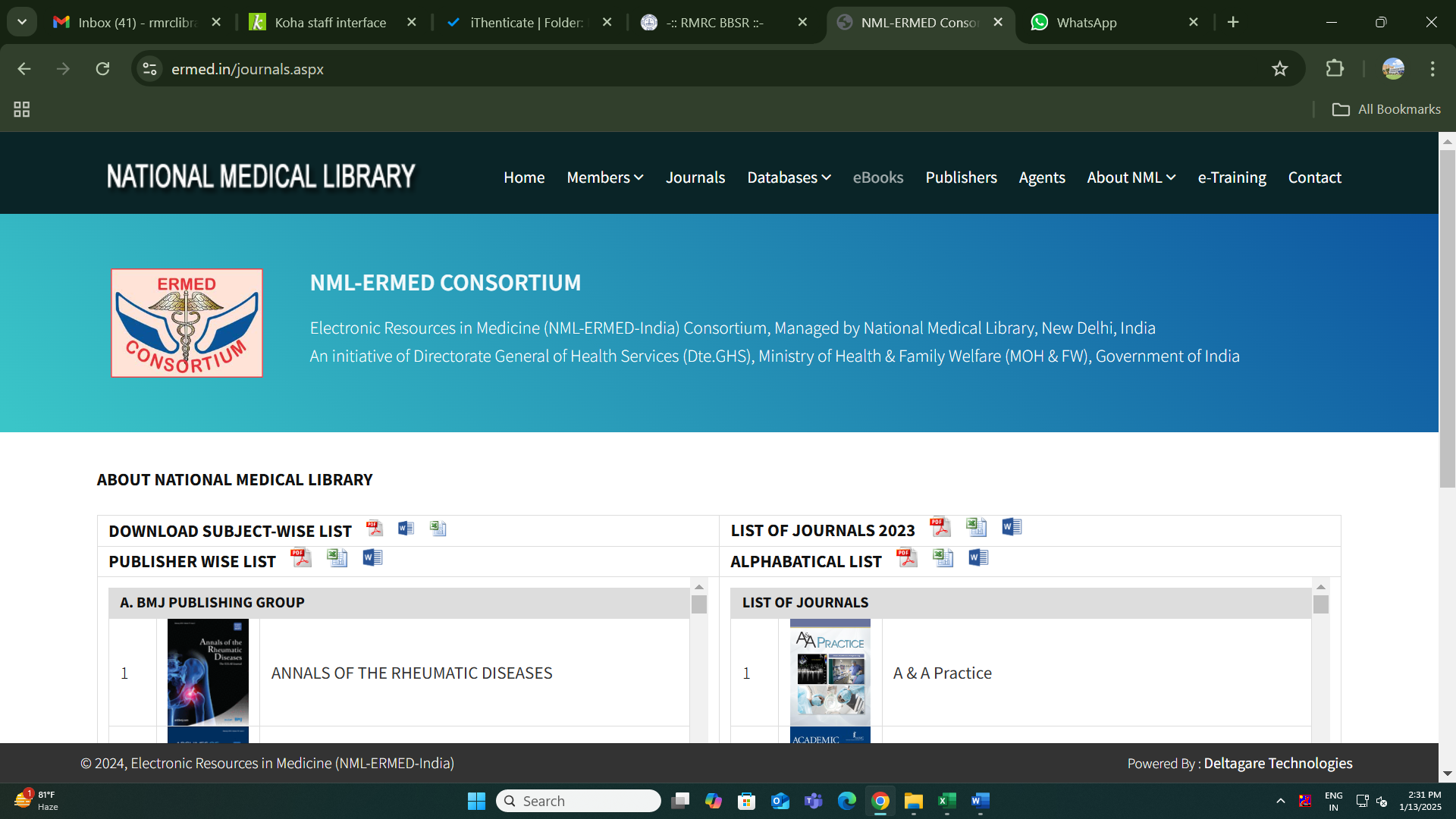
EBSCO Database(CINAHL):
EBSCO Information Services is a prominent provider of research databases, e-books, and library services to academic, corporate, and medical institutions. They offer extensive access to scholarly articles, journals, and magazines across various disciplines. Their Discovery Service simplifies research by enabling users to search multiple databases through a single interface. Additionally provides library management solutions and specializes in medical and healthcare resources, serving diverse information needs. For up-to-date details, refer to EBSCO's official website i.e. http://search.ebscohost.com.
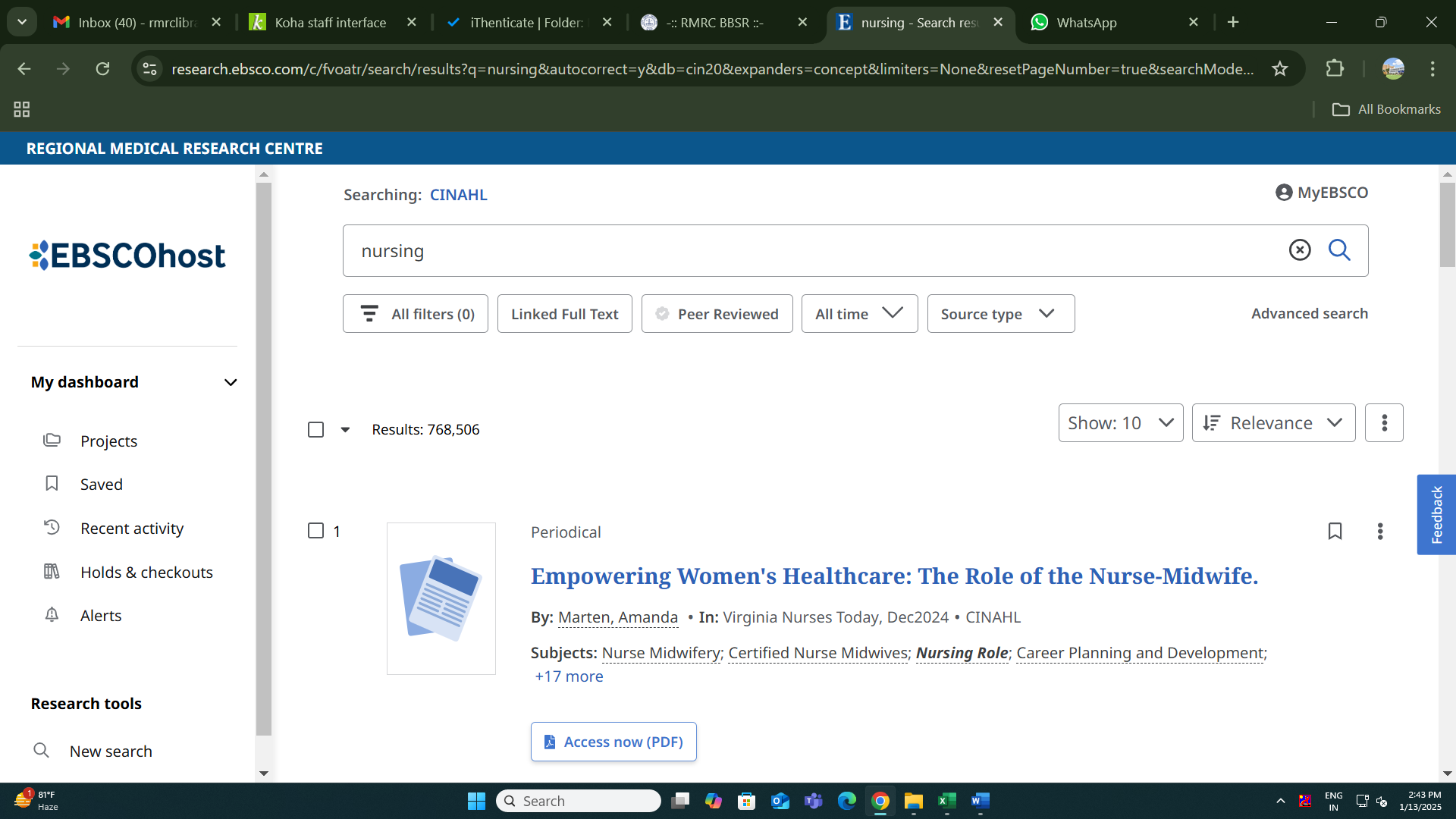
ProQuest:
ProQuest is a prominent digital library and research platform that offers access to an extensive range of scholarly content, including journals, theses, dissertations, newspapers, and more. It serves students, researchers, and libraries by providing a vast collection of resources across various disciplines. ProQuest's user-friendly interface simplifies information discovery and supports academic research. It's a valuable tool for accessing credible and diverse sources for scholarly pursuits. For current details, refer to ProQuest's official website i.e. www.proquest.com.
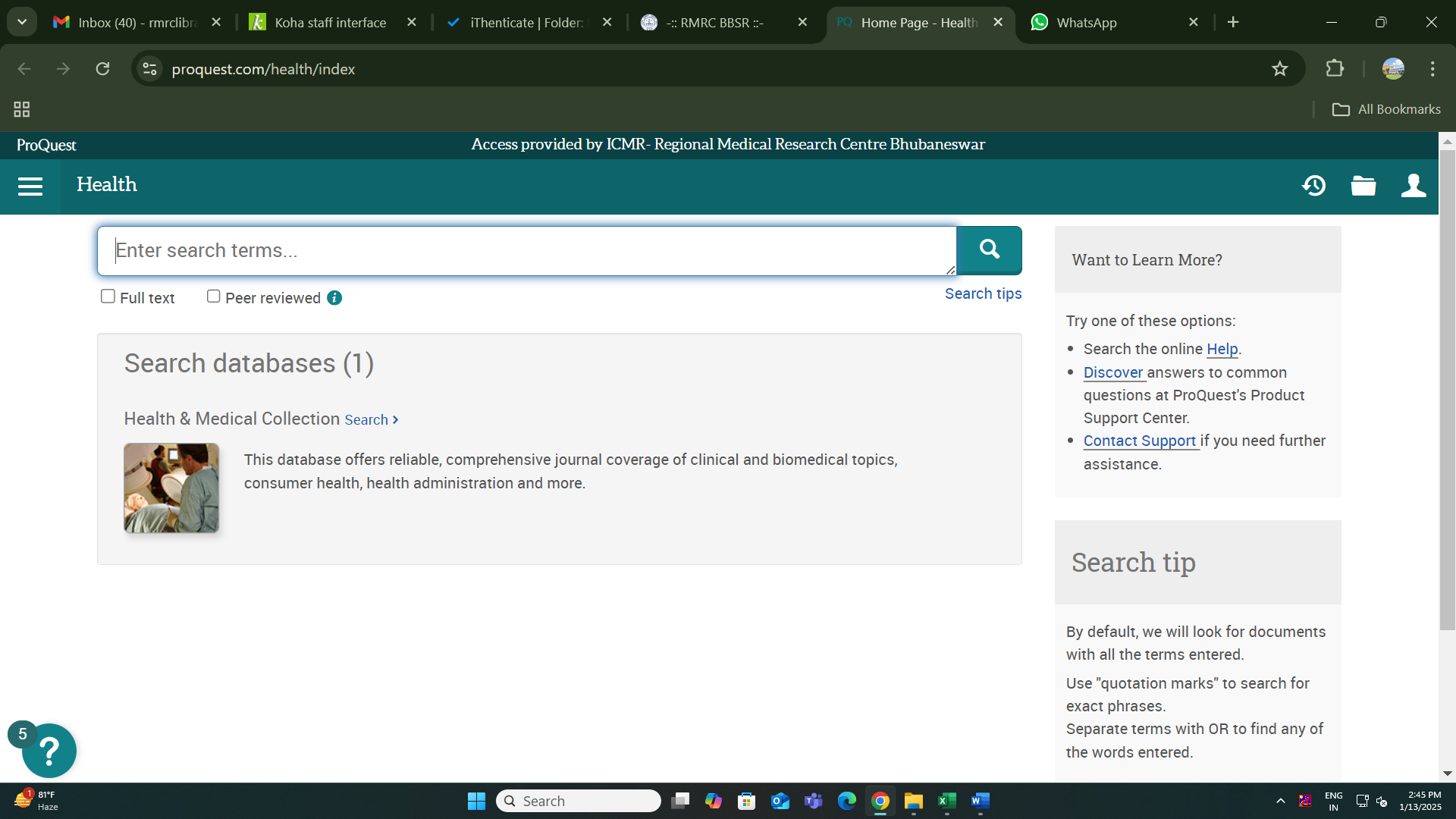
Plagiarism Software iThenticate:
iThenticate is the premier tool for researchers and professional writers to check their original works for potential plagiarism. With an easy to use submission process that checks for similarity against the world’s top published works, researchers and institutions can feel confident that their academic reputation will be protected. It seamlessly integrates with content and manuscript systems. CrossCheck, a collaborative version with CrossRef, gained acclaim for innovation. Noteworthy cases include Hartford Courant and Ann Coulter's book controversy, highlighting iThenticate's impact beyond detection. It is used for antiplagiarism check. The library procures iThenticate for similarity index for the manuscripts sent for publication by scientists, research scholars and students.
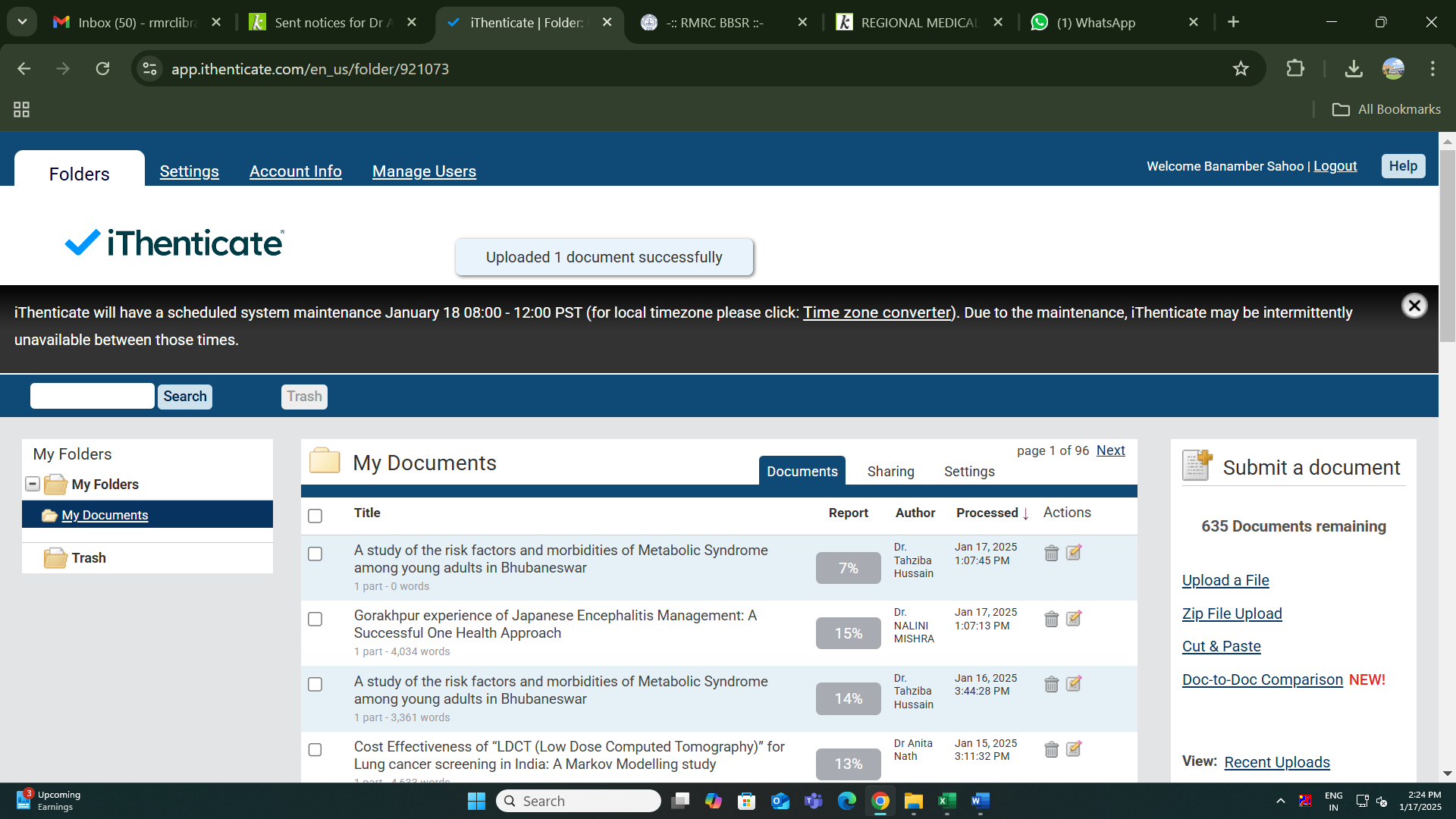
Online Public Access Catalogue (OPAC)
An Online Public Access Catalogue (OPAC) is a digital catalog system used by libraries to provide users with easy access to their collections of books, journals, multimedia, and other resources. As a replacement for the traditional card catalogue system, OPAC offers a more efficient and user-friendly way to search for, locate, and interact with library materials.With OPAC, users can conduct searches based on various criteria, such as keywords, authors, titles, subjects, or publication dates. The system is typically accessible online, enabling users to explore the library’s resources remotely or on-site. In addition to basic search functionality, many OPAC systems offer advanced features like real-time availability updates,
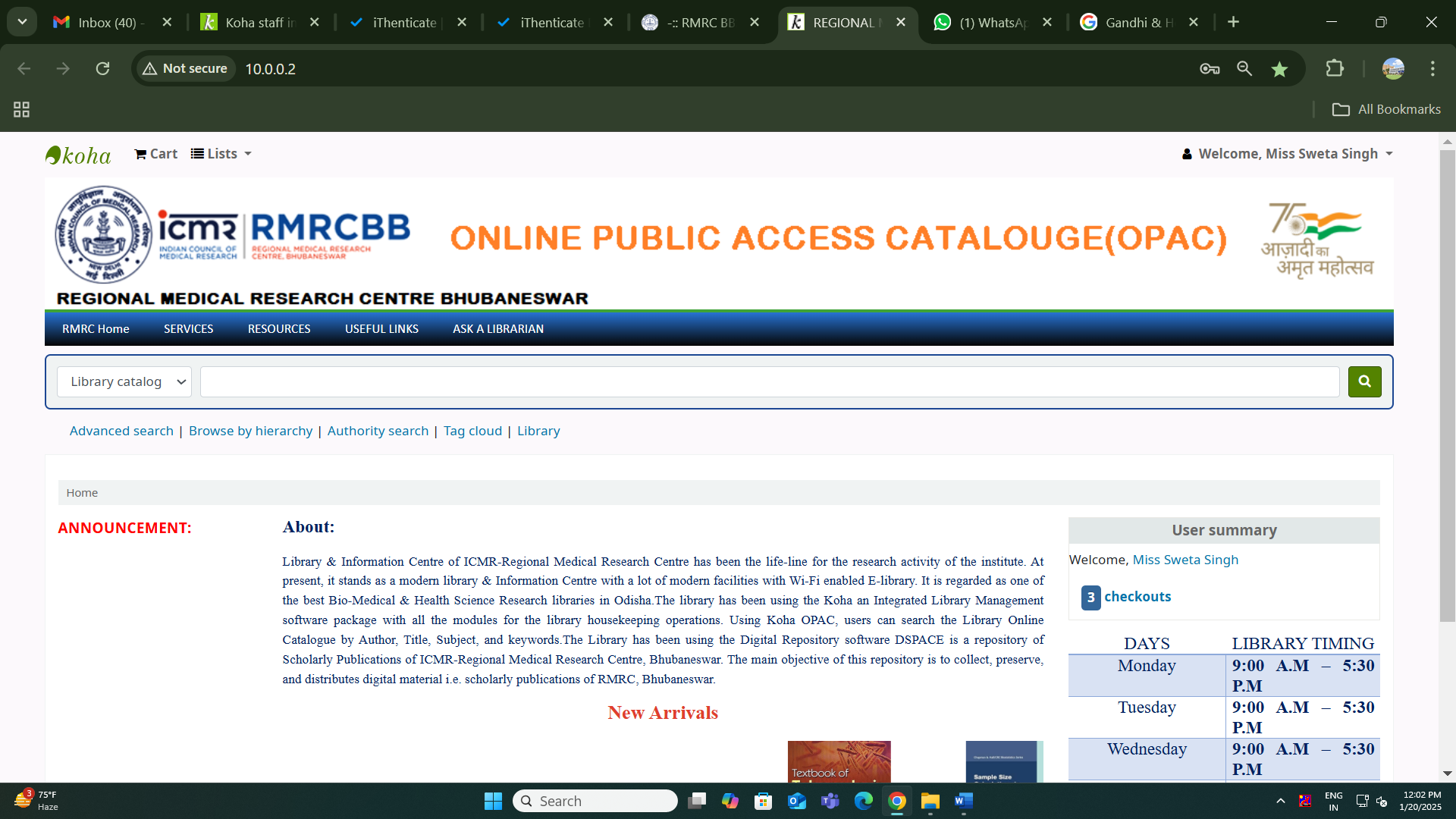
resource reservations, borrowing history tracking, and account management.
OPAC systems are often integrated into a library’s overall automation framework, streamlining processes like circulation, cataloguing, and acquisitions for library staff. Beyond physical collections, OPAC can also include access to digital resources, such as e-books and online journals, making it a comprehensive tool for both library users and administrators. By enhancing accessibility and efficiency, OPAC plays a critical role in modernizing libraries and improving the overall experience for patrons.
KOHA Automated Library Management System
Koha is the first of its kind, an open-source integrated library software (ILS) used worldwide by all kinds of libraries from public, academics and special libraries. Its growth and development is guided by a nurturing community of libraries and users across the world, who collaborate together to achieve its technological objectives and goals. The name of the ILS become Koha from a term called Mãori which means a “gift” or “donation”. The ILS is developed at a modern platform and is a web-based solution for the libraries. Koha uses SQL database (MySQL preferred) as backend and its cataloguing data stored is in MARC and is accessible via Z39.50 protocol.
Koha is integrated library software that has state of the art web-based
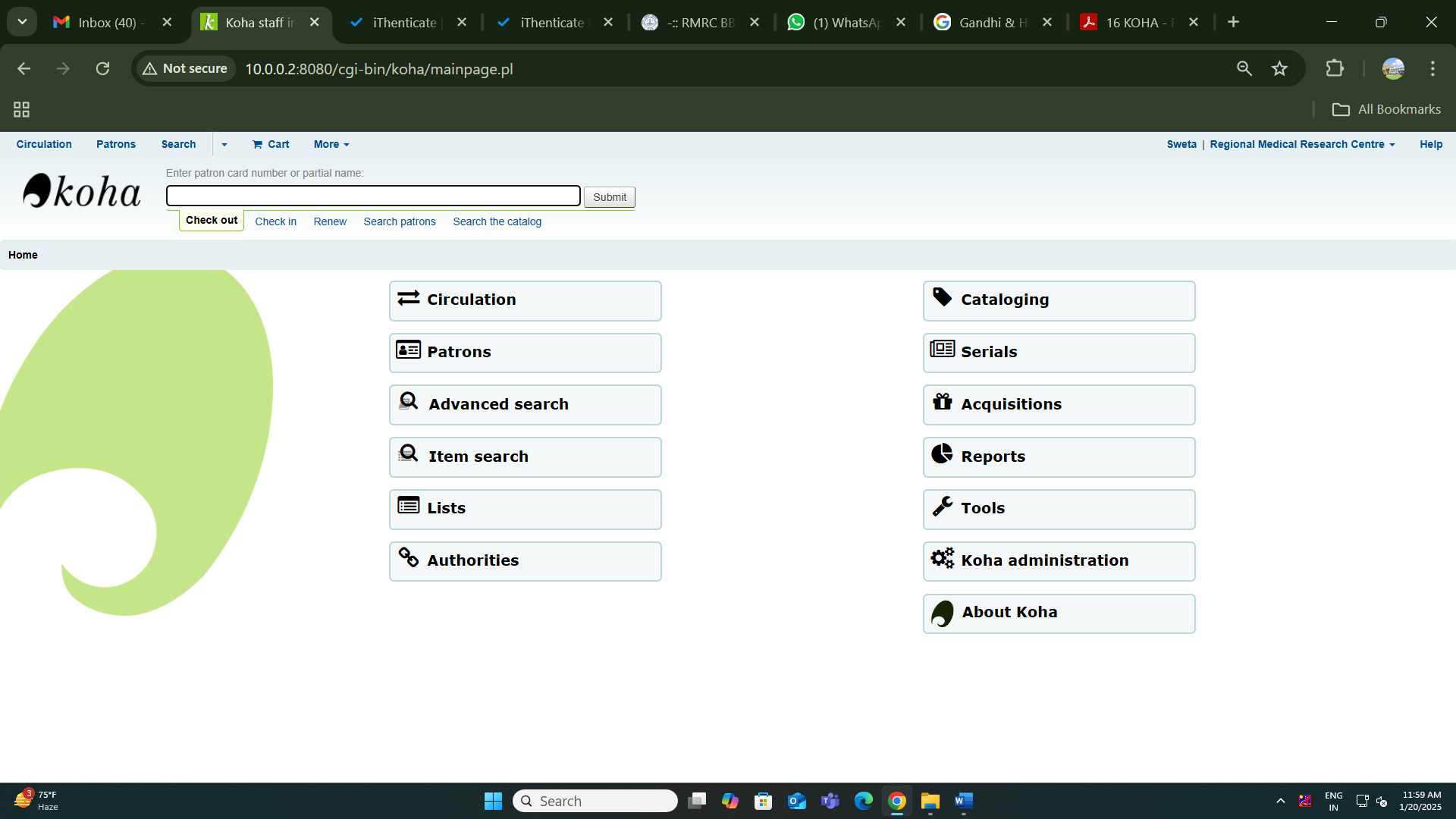
interface, enhanced content and substance, provides faceted navigation, provision for keyword searching, up- gradation and development through user contribution and provides Rich Site Summary (RSS) feeds that make it unique integrated library software in the world. At present Koha has four specific language websites including French, Chinese, Italian and Spanish.
Software for Researchers
1. MAXQDA data analysis software (10 users)
MAXQDA is a software program designed for computer-assisted qualitative and mixed methods data, text and multimedia analysis in academic, scientific, and business institutions. It is being developed and distributed by VERBI Software based in Berlin, Germany. MAXQDA is designed for the use in qualitative, quantitative mixed methods research. The emphasis on going beyond qualitative research can be observed in the extensive attributes function (called variables in the programme itself) and the ability of the programme to deal relatively quickly with larger numbers of interviews.
2. NVIVO data analysis software (MPH academic program)
NVivo is Lumivero's easy-to-use, collaborative qualitative analysis software that allows researchers to import, organize, explore, connect and collaborate on their data to reveal more significant insights from their qualitative data faster. NVIVO software allows you to:
- Organize and code multiple data sources in one central project.
- Assign attributes to data (e.g., demographics) for comparative purposes.
- Add interpretations and notes.
- Query and search data.
- Visualize data with text mining.
- Share both data and results.
3. Graph Pad statistical software (10 Users)
GraphPad is a leading software suite designed for streamlined data analysis and visualization. At the core of its offerings is GraphPad Prism, a powerful tool favored by researchers and scientists. With an intuitive interface, Prism enables effortless graph creation, precise statistical analyses, and curve fitting. Researchers across diverse domains, from life sciences to social studies, rely on GraphPad to simplify data interpretation and presentation. By transforming raw data into insightful visuals and meaningful results, GraphPad enhances research communication and decision-making processes.
4. STATA (9 users)
Stata is an advanced statistical software edition, building upon Stata's capabilities. It offers enhanced features for managing larger datasets, conducting intricate analyses, and advanced data manipulation. Researchers, professionals, and analysts benefit from its expanded toolkit for statistical modeling, data visualization, and research exploration. StataSE-16 empowers users to delve deeper into data insights, making it a valuable tool for complex research projects and data-driven decision-making.
5. EndNote X8 (20 Users)
EndNote is a reference management software package which is used to manage bibliographies and references when writing assignments, dissertations, theses and articles. The software is available for both PC and Mac, and there is a web version which you can use anywhere. EndNote allows you to:
- Store all the references that you find during your research. They can be exported automatically from most databases, or entered manually.
- Store PDF files, pictures, graphs, tables, etc.
- Add citations to your work and create bibliographies in any output style (e.g. APA, Chicago, MLA and Vancouver). There are over 6,000 styles to choose from.
6. Infograpia (One Time License)
Infograpia.com is a platform known for offering a wide range of infographic templates that cater to various subjects and themes. It provides users with the tools to easily create visually engaging and informative graphics, enhancing the communication of complex ideas. With its user-friendly interface, Infograpia.com simplifies the process of crafting compelling visual content.
7. Covidence systematic review software (50 reviews per year)
Covidence is a web-based software platform designed to streamline the process of conducting systematic reviews. It offers a range of features to support researchers, including:
- Efficient screening: Enables collaborative screening of studies by multiple reviewers, reducing bias and improving accuracy.
- Data extraction: Facilitates the extraction of key data from included studies into a structured format.
- Risk of bias assessment: Helps researchers assess the risk of bias in included studies using standardized tools.
- Collaboration tools: Allows for seamless collaboration among team members, including communication, task assignment, and progress tracking.
- Reporting features: Generates customizable reports and flow diagrams, aiding in the preparation of systematic review manuscripts.
By automating many of the time-consuming tasks associated with systematic reviews, Covidence can significantly improve the efficiency and quality of research.
8. nMaster sample size calculation software
nMaster is a software that incorporates sample size calculation in terms of contents, each of use and the cost. When planning a study design, it is very imperative to consider how many participants are needed, therefore, sample size must be premeditated carefully to ensure that the research time, patient effort and support costs invested are not wasted.
Library Manpower Development Program
Regional Medical Research Centre, Bhubaneswar is one of the Biomedical Research Centers of the Indian Council of Medical Research (ICMR), Ministry of Health & Family Welfare, Govt. of India. The Centre's library is recruiting Apprentice library trainees with fixed stipend amount for the period of one year which is approved by ICMR, New Delhi, and Board of Practical Training (BOPT), Kolkata since 2009. The fixed stipend amount Rs. 5000.00 per month has been enhanced to Rs. 11,500.00 per month since 2011. Only current year MLISc pass-out students are eligible for Library apprentice trainee for the period of one year. During training, the trainees are exposed to the following activities.
- Total Housekeeping operation of RMRC Library (Acquisition, technical processing, Classification in UDC & Serial Control, etc.)
- Working on Library Automation Software- Koha
- Institutional Repository (IR) of RMRC Scientific Publications
- Online literature search through ERMED consortia, EBSCO Database, EMBASE, ProQuest.
- Scanning, Digitizing, Resource Sharing and News Clippings on local health news
- Bibliometric analysis/activities.
Presently 15th batch trainees are continuing. The details of the apprentice trainees since 2009-2024 are as follows:
| 1st batch trainees: (2009-2010) | Snigdharani Sahu , MLISc. (SU), Ruchismita Prusty, MLISc. ( NOU) |
| 2nd batch trainees: (2010-2011) | Rameswar Meher, MLISc. (SU), Rajendra Mohan Kissan, MLISc. (SU) |
| 3rd batch Trainees: (2011-2012) | Puspita Mishra, MLISc. (UU), Nibedita Senapati, MLISc. (SU) |
| 4th batch trainees: (2012-2013) | Nikita Bisi, MLISc. (SU), Ratnapriya Bhoi, MLISc. (SU) |
| 5th batch trainees: (2013-2014) | Dhara Sharma, MLISc. (UU), Nasima Begum MLISc. (UU), Mukesh Kumar Bhoi, MLISc. (SU) |
| 6th batch trainees: (2014-2015) | Miss Priyanka jee, MLISc. (UU), Miss Lipika Sharma, MLISc. (SU) |
| 7th batch trainees: (2015-2016) | Mr. Prabhat Ku Swain, MLISc. (UU), Miss. Lipika Rani Nayak, MLISc. (SU) |
| 8th batch trainees: (2016-2017) | Mr. Satyajit Nayak, MLISc. (UU), Miss Twinkle Rout, MLISc. (UU) |
| 9th batch trainees: (2017-2018) | Mrs. Hemanti Mahali MLISc.(IGNOU), Miss. Poonam Sing Deo, MLISc. (PU) |
| 10th batch trainees: (2018-2019) | Mr. Shakti Ranjan Barik, MLISc. (NOU), Miss. Sonali Srivastav, MLISc. (SU) |
| 11th batch trainees: (2019-2020) | Mr. Suryajit Samal, MLISc. (UU), Miss Adyasa Bhoi, MLISc. (SU) |
| 12th batch trainees: (2021-2022) | Mr. Nilakantha Dash, MLISc. (UU), Miss Payal Jena, MLISc. (FMU) |
| 13th batch trainees: (2022-2023) | Mr. Ajay Kumar Saw, MLISc. (UU), Shibashakti Digal, MLISc. (UU) |
| 14th batch trainees: (2023-2024) | Mr. Bikash Kumar Sahoo, MLISc. (UU), Sunil Gomango, MLISc. (UU) |
| 15th batch trainees: (2024-2025) | Mr. Debasish Kumar Behera, MLISc. (UU), Miss. Sweta Singh, MLISc. (UU) |
Proud Library Trainee of RMRC

(now working in NIT, Rourkela)

(now working in CSIR-CRRI, New Delhi)

(now working in Govt. of Odisha Library)

(now working in Govt. of Odisha Library)

(now pursuing Ph.D. in Manipur)

(now working in NIT, Rourkela)

(now pursuing Ph.D. In Gangadhar Meher University)

(now working in NCERT, New Delhi)

(now working in Ramadevi University)

(now working in KIIT University)

(now working in Govt. College)

(now working in AIIMS, Bhubaneswar)

(now working in Govt. of Odisha Library)
Publishing Cell
Library works as publication cell of the institute. It regularly publishes Annual Report, IEC materials on specific diseases and special publications. During Centenary year of ICMR (2011), the several publications are published by the publication cell. Recently 9 books published by ICMR-RMRC, Bhubaneswar and allotted ISBN from Raja Ram Mohan ISBN Agency, New Delhi..
- Gandhi & Health @150 (Odia)
- Odi-Sci: The ODYSSEY of the Women Scientists of Odisha (English)
- Bigyana Bidusi: Odishara Nari Gabesika (Odia)
- Bigyana Bidusi: Odishara Nari Gabesika (Hindi)
- Occurrence, Determinants and Outcomes of Multimorbidity in Primary Care: The Indian Landscape
- Antimicrobial Stewardship Program: Training Module for Medical Officers
- Antimicrobial Stewardship Program: Training Module for Pharmacists
- Training Module on Management of Anthrax for Medical Officials
- Training Module on Management of Anthrax for Veterinary Officials
- Training Module on Management of Anthrax for Laboratory Technicians





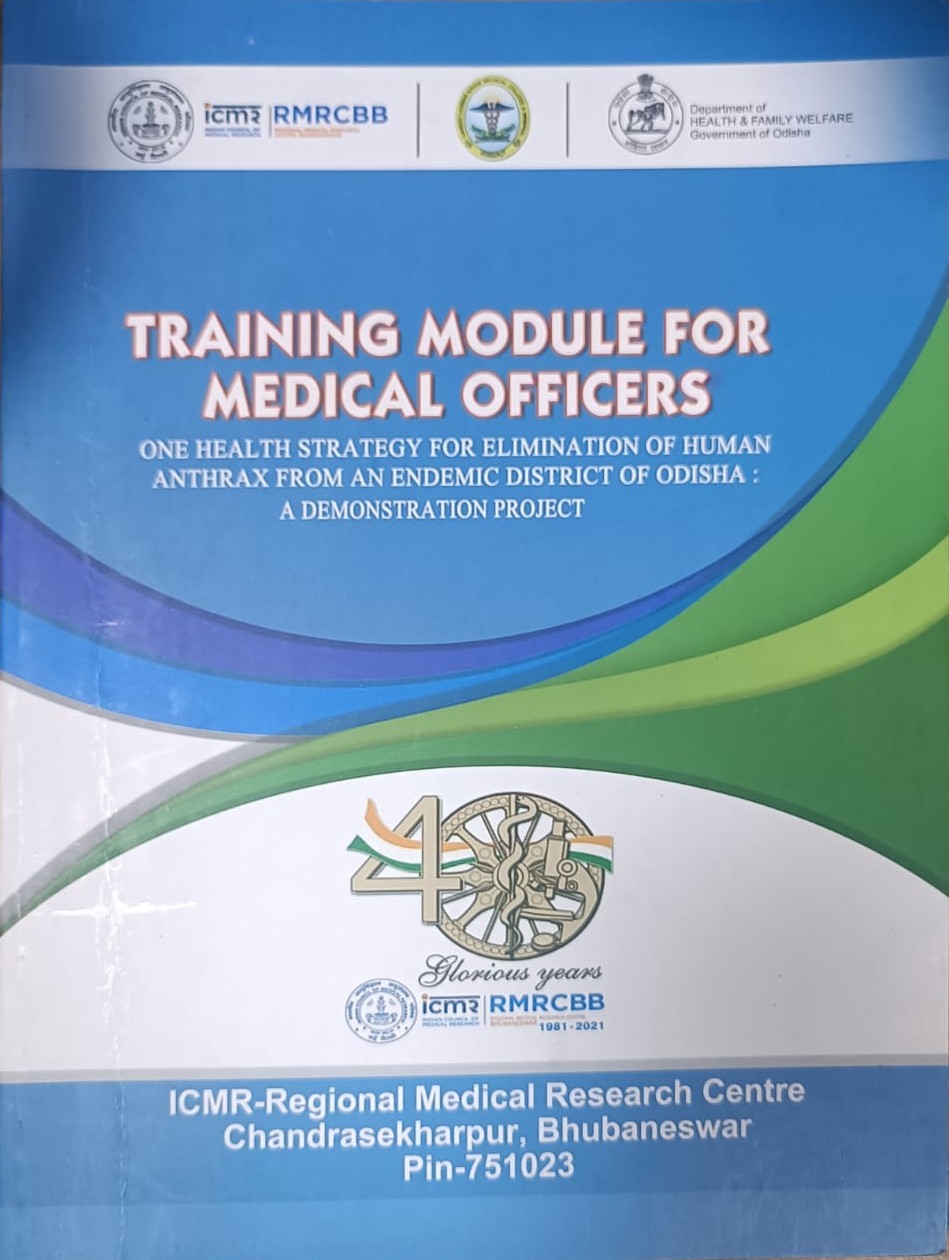
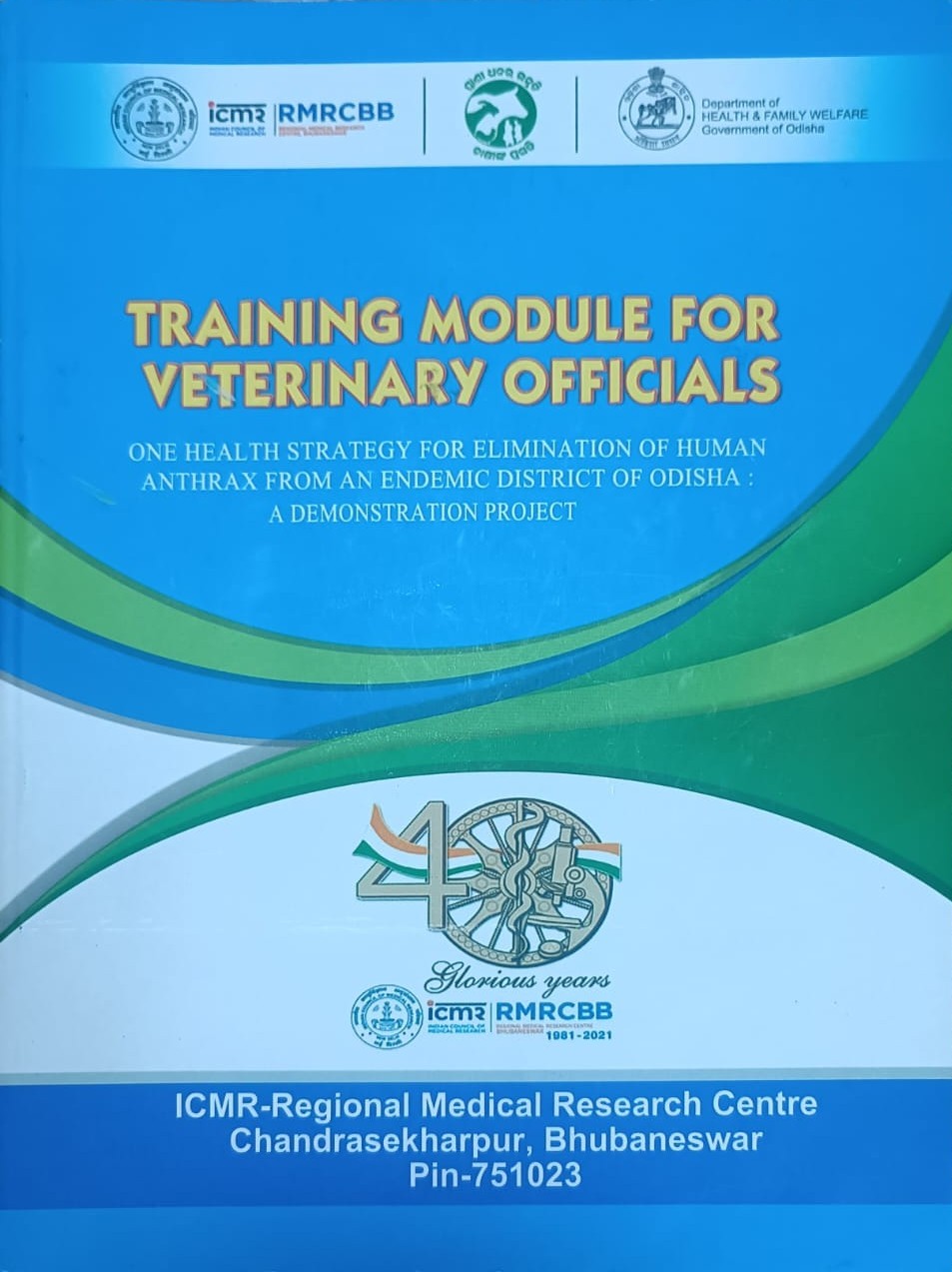

Coordinating HRD Activities:
Library works as coordinator for short-term Dissertation program and summer internship program of M.Sc./MPH students from various universities as 6 monthly project works at RMRC Bhubaneswar.
RMRC LAN System:
RMRC Local Area Network (LAN) is connected to all scientists, divisions and section for Internet & Intranet connectivity. At present, the library is equipped with LAN Server connected with more than 250 computers in the RMRC building, Annex Building, OPD Building. Besided LAN server, Mail-server, Antivirus- server and Koha Server are also installed in Library for Networking. Two leased likes i.e. NKN and NIC for Web OPAC with BSNL leased line and National Knowledge Network (NKN) for Internet connectivity.
Journal Impact Factor(JIF)
The impact factor (IF) or journal impact factor (JIF) of a journal is a quantitative tool for evaluating the relative importance of a journal. It is a measure of the frequency with which its published papers are cited up to two years after publication. The impact factor, proposed by Eugene Garfield, is a ratio between citations and recent citable items published. It is calculated by dividing the number of current year citations to the source items published in that journal during the previous two years by the number of published articles in that journal during the precious two years.

A higher impact factor generally indicates that the journal’s articles have been cited more.
h-Index
The h-index is a number intended to represent both the productivity and the impact of a particular scientist or scholar, or a group of scientists or scholars (such as a departmental or research group). The h-index is calculated by counting the number of publications for which an author has been cited by other authors at least that same number of times. For instance, an h-index of 17 means that the scientist has published at least 17 papers that have each been cited at least 17 times. If the scientist's 18th most cited publication was cited only 10 times, the h-index would remain at 17. If the scientist's 18th most cited publication was cited 18 or more times, the h-index would rise to 18.
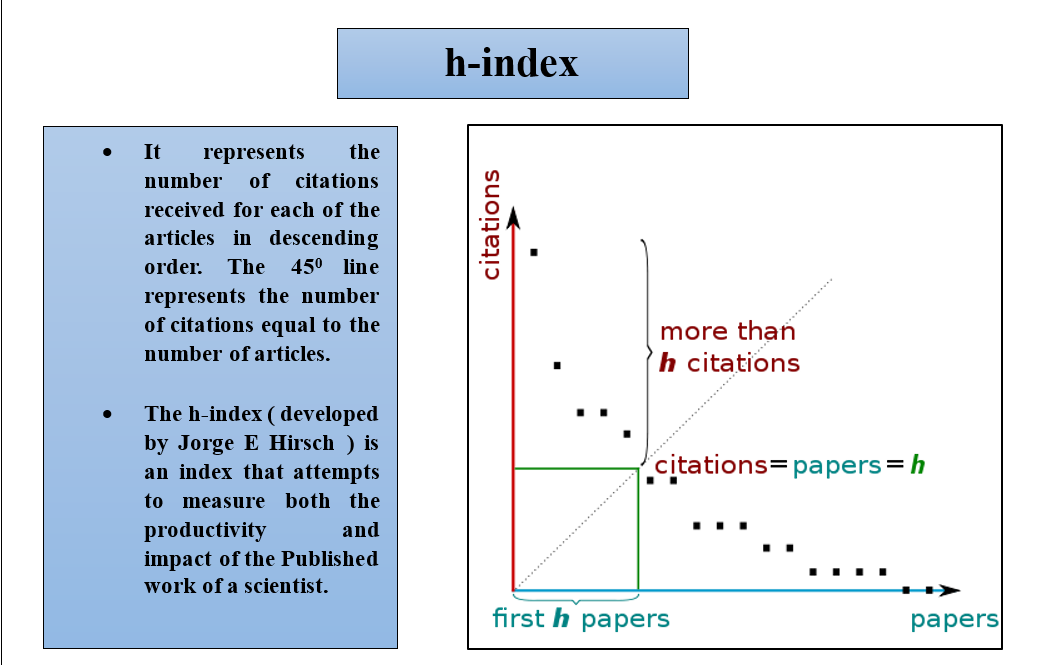
IT Infrastructure
The institute features a well-strcutered and scalable IT infrastructure, anchored by a koha library management server housed in the library's central hub. IT infrastructure is managed by a skilled and dedicated team of professionals led by Dr. Banamber Sahoo, the Principal Technical Officer and IT In-Charge, who oversees the overall technological stategy and operations.The team includes:
- Er. Deeptendu Roy: Project Engineer working on E-Office who ensures the seamless functioning of digital communication systems and workflow automation, E-Governance, IRRAS, etc.
- Er. Swadhin Kumar Sahoo and ER. Samir Kumar Mahakud: Network Engineers responsible for designing, maintaining, optimizing and troubleshooting the institute's extensive network infrastructure.
- Er. Sandeep Kumar Sahoo: Web Developer who manages the institute's online platforms and content delivery.
To foster research and innovation, we provide high-bandwidth, secure Wi-Fi access to project staff and dissertation/internship for reading, browsing, and data-intensive research activities. The institute also leverages the NIC CFMS cloud server for resource management, ensuring efficient, scalable, and secure cloud operations.
